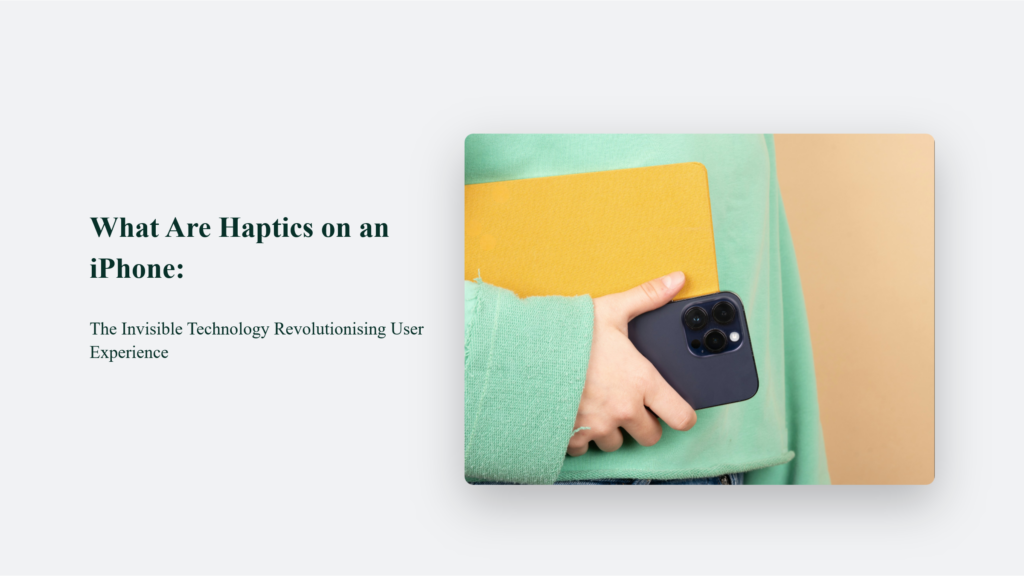You’re scrolling through your iPhone, mindlessly flicking past posts and ads, when suddenly your thumb stops. You’ve felt a subtle vibration, a gentle tap against your skin. But it wasn’t just a plain old vibration. It was precise, almost like a physical confirmation of your action. Welcome to the world of haptics on iPhone, the invisible technology you use every day without realising it and let’s find out what are haptics on an iPhone.

What are Haptics on an iPhone: More Than Just Good Vibrations
Let’s start with the basics. What are haptics? Simply put, haptic technology, or haptics is the science of touch in the digital realm. It’s about creating tactile sensations to enhance user interactions with electronic devices. On your iPhone, haptics are why pressing a virtual button feels somewhat like pressing a physical one.
But here’s where it gets really interesting: iPhone haptics aren’t just random vibrations. They’re carefully designed tactile responses that play a crucial role in how we interact with our devices. The magic behind these subtle vibrations is Apple’s Taptic Engine, a linear actuator that can create a wide range of haptic patterns.
The Taptic Engine is like a tiny, sophisticated drum inside your iPhone. It can create various vibration patterns, from sharp taps to longer buzzes, each designed to convey different types of information. This technology allows your iPhone to ‘speak’ to you through the sense of touch, creating a more intuitive and immersive user experience.
The Evolution of iPhone Haptics: From Buzz to Finesse
Remember the early days of mobile phones? Your phone would buzz like an angry bee when a call or message came in. Those were the days of simple vibration motors, which were about as subtle as a sledgehammer.
But Apple, being Apple, wasn’t satisfied with this crude approach. They wanted to make interactions feel more natural, more… human. Enter the Taptic Engine, introduced with the iPhone 6s. It was a game-changer, allowing for more nuanced and varied haptic feedback.
Since then, the haptic capabilities of iPhones have only grown more sophisticated. The latest iPhones can produce an incredible range of tactile sensations, from the gentle tap of a button press to the satisfying click of a virtual switch.
Types of Haptic Feedback on iPhone: A Symphony of Touch
Now, let’s break down the different types of haptics you might encounter on your iPhone. There are three main categories:
- System Haptics: These are the tactile responses you feel when interacting with your iPhone’s core functions. Think of the subtle vibration when you toggle a switch in the Settings app or the sharp tap when you press and hold an app icon on the home screen.
- UI Haptics: These are the tactile sensations associated with user interface elements. For example, the gentle bump you feel when scrolling through a picker wheel, or the subtle feedback when you press a button in an app.
- App-specific Haptics: App developers can incorporate custom haptic patterns into their apps. For instance, a game might use haptics to simulate the recoil of a gun or the impact of a car crash.
But here’s the kicker: these categories often overlap and work together to create a seamless, intuitive experience. It’s like a symphony of touch, with each haptic event playing its part in the overall composition of your iPhone experience.
The User Experience Impact: Touching Without Touching
Now, you might be thinking, “So what? It’s just a bunch of fancy vibrations.” But oh, my friend, it’s so much more than that. Haptics are fundamentally changing how we interact with our devices and, by extension, the digital world.
Consider this: when you type on your iPhone’s keyboard, you feel a subtle tap with each key press. This tactile confirmation mimics the feeling of typing on a physical keyboard, making the virtual keyboard feel more real and responsive. It’s enhancing user experience in ways we often don’t consciously notice.
But the impact of haptics goes beyond just making things feel nice. For users with visual impairments, haptics can be a crucial accessibility feature. Tactile feedback can provide important information about what’s happening on the screen, allowing these users to navigate their iPhones more easily.
And let’s not forget the emotional aspect. Have you ever noticed how satisfying it feels to pull down to refresh a page on your iPhone? That’s haptics at work, creating a sense of physicality in the digital realm. These little touches (pun intended) can significantly boost user satisfaction and create a stronger emotional connection with our devices.
Haptics and Mobile Marketing: The Touch of Success
Now, let’s talk business. If you’re a marketer or app developer, you might wonder how to leverage haptics to enhance user interactions with your brand.
Imagine an e-commerce app that uses haptics to simulate the texture of products or a meditation app that uses gentle vibrations to guide breathing exercises. The possibilities are endless, and they’re only just beginning to be explored.
Incorporating haptic feedback into your mobile marketing strategy can create more engaging and memorable user experiences. It’s another sensory channel to communicate with your audience, adding depth and richness to your digital interactions.
But a word of caution: with great power comes great responsibility. Overusing haptics can be just as annoying as overusing pop-up ads. The key is to use haptics thoughtfully and purposefully, enhancing the user experience rather than distracting from it.
The Future of Haptics: A Brave New World of Touch
So, where do we go from here? As technology continues to advance, the possibilities for haptics are expanding rapidly. We’re already seeing the integration of haptics with augmented reality (AR) and virtual reality (VR) experiences, allowing users to ‘feel’ virtual objects.
Imagine playing a VR game where you can feel the texture of a virtual sword in your hand, or an AR app that lets you ‘touch’ historical artifacts. These aren’t just pipe dreams – they’re the direction in which haptic technology is heading.
But it’s not all smooth sailing. There are challenges to overcome, such as the impact on battery life (those vibrations don’t come for free, energy-wise) and the need for standardisation across devices and platforms.
Managing Haptics on Your iPhone: Taking Control
Now, let’s get practical. How can you, as an iPhone user, manage haptic feedback on your device?
- Go to Settings > Sounds & Haptics > System Haptics to turn haptic feedback on or off system-wide.
- You can also adjust the intensity of haptics in the same menu.
- Some apps allow you to manage haptic feedback within their settings.
- If you’re concerned about battery life, disabling haptics can help extend it slightly.
Remember, the beauty of haptics is that they’re customisable. Don’t like the way something feels? Change it! It’s all about making your iPhone feel right for you.
Conclusion: The Invisible Revolution
As we wrap up, let’s take a moment to appreciate the invisible revolution happening right in the palm of our hand. Haptics on iPhone is fundamentally changing how we interact with our devices, making our digital experiences more tactile, more intuitive, and more human.
From enhancing accessibility to creating emotional connections, from improving user satisfaction to opening new avenues for mobile marketing, haptics are quietly reshaping our digital world.
So the next time you feel that subtle vibration, that gentle tap against your finger, take a moment to appreciate it. It’s not just a vibration – a conversation between you and your device, a physical manifestation of the digital world.
And who knows? As haptic technology continues to evolve, we might be on the cusp of a new era of digital interaction – one where the line between the physical and digital worlds becomes increasingly blurred.
Now, that’s something worth feeling excited about.
Frequently Asked Questions:
Can I customise the intensity of haptic feedback on my iPhone?
Yes, you can adjust the intensity of haptics. Go to Settings > Sounds & Haptics, and under “Haptics”, you can choose between “Light”, “Medium”, or “Strong” vibrations.
What is the Taptic Engine in iPhones?
The Taptic Engine is Apple’s haptic feedback system. It’s a linear actuator that creates precise and varied tactile sensations, allowing for more nuanced and realistic haptic feedback compared to traditional vibration motors.
Do all iPhone models have haptic feedback?
While all modern iPhones have some form of haptic feedback, the sophistication of the haptics has evolved over time. The Taptic Engine, which provides more advanced haptics, was introduced with the iPhone 6s and has been refined in subsequent models.




